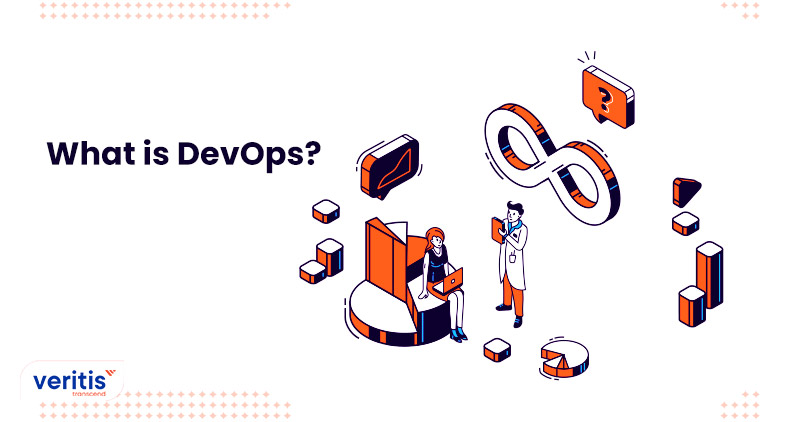Table of contents
What is DevOps?
DevOps. This is the production methodology that is propelling innovation worldwide. While the pandemic ravaged the world, the global populace’s reliance on IT products increased astronomically. Along with the demand, the need for reliable, resilient products was high. However, developing error free products with outdated production approaches was no longer viable, and the companies harnessed DevOps. But what exactly is DevOps? Another question mostly follows: What are DevOps tools?
One of the most innovative approaches we have recently discovered is DevOps, which has led the way to DevOps best practices alongside DevOps services.
It was well known how difficult it was to develop software using rigid methodologies like the waterfall model. The fundamental tenet of DevOps, which drives its development, is that development and operations teams can collaborate to produce better outcomes without having to operate like assembly line workers.
Due to the team’s cohesion, DevOps team members began to realize benefits, including faster development and deployment, simpler testing, and continuous integration and continuous delivery (CI/CD). The latter enables project participants to improve the final product as needs change continuously.
DevOps is a mindset that enables improved communication and collaboration among these teams and other groups. DevOps uses iterative software development, automation, and programmable infrastructure deployment and maintenance in its most limited sense. The phrase also implies that developers and operational staffing members work together to achieve the objectives. DevOps can alter the software delivery process, services, employment responsibilities, IT tools, and best practices. In turn, the resources utilized have become DevOps processes, DevOps tools, and DevOps principles, which are now associated with DevOps strategy.
Although DevOps is not a technology, environments that use it frequently use standard approaches. They consist of the following:
1) Scope for continuous integration and continuous delivery (CI/CD), also known as continuous deployment, with a focus on an automated DevOps pipeline.
2) Collaboration platforms, real time monitoring systems, incident management systems, configuration management systems, and other services and solutions that support DevOps adoption strategy.
3) DevOps services, microservices, containers, and cloud computing are used alongside DevOps techniques.
The DevOps methodology is one of the methods IT workers use to deliver IT projects that satisfy business goals. Agile and service management frameworks like ITIL, project management guidelines like Lean and Six Sigma, and other tactics can coexist with DevOps principles.
How Does DevOps Work?

DevOps transformation is a methodology that aims to enhance productivity throughout the whole software development lifecycle (SDLC). Plan, code, test, deploy, monitor, and — through feedback — plan and allow the cycle to repeat. This infinite loop is one of the most distinctive traits of DevOps, and the loop is often termed the CI/CD pipeline.
DevOps principles imply that an IT team creates software that satisfies user requirements, deploys quickly, and performs well immediately. Businesses use a mix of culture and technology to drive a successful DevOps transformation.
Developers and project managers should discuss the project and collaborate on incremental upgrades, which shall go live independently of one another, to align the product with expectations. The IT teams shall witness seamless code development and deployment moments with the CI/CD pipeline with stunted production duration.
The DevOps lifecycle employs containers or other techniques to ensure the program behaves consistently from development through testing and into production to release good code. Developers should support the software if it has a massive shelf life.
Useful link: Pros and Cons of DevOps Methodology and its Principles
Why DevOps Matters
Although every organization has difficulties, common issues include delayed releases, subpar software, and IT restricting business expansion.
By moving from idea to live software, companies can better take advantage of market opportunities. The DevOps model gives organizations a competitive edge in this approach. Software development expert Patrick Debois is credited with coining the phrase DevOps services by branding the conference DevOps Days in 2009.
IT managers resented the sometimes tedious and excessively complicated change management stages in the ITIL framework as Agile was pushed deeper into operations. Agile promotes collaboration and progress, whereas ITIL champions stable, trustworthy, and predictable IT. DevOps principles moved people on both sides. Organizations may use ITIL and DevOps, especially if they embrace the cloud.
The Phoenix Project, a book published in 2013, helped to popularize the term “DevOps further.” The Phoenix Project employs a fictitious story to highlight persistent issues and aid IT administrators in comprehending the ideas and advantages of teamwork and shared technologies.
As DevOps solutions gained popularity, businesses formalized DevOps methods. Retailer Target, for instance, developed a DevOps lifecycle. In addition to communication chatbots and CI/CD suites integrated into cloud services, vendors highlighted the technologies’ ability to support DevOps. As a result, the title DevOps engineer skills quickly became popular.
DevOps is still developing, as artificial intelligence is used to help with everything from incident management to code creation. Before AI for DevOps (or AIOps) becomes a reality, many obstacles must be overcome, including more innovative automation, reduced wait times, and smoother translation of business demand into technology.
While cloud DevOps services have become widely accepted, not all early adopters fully embrace them. Many people use a DevOps strategy for IT projects that generate income because they get a return on their investment in cutting edge equipment and expertise. However, DevOps technologies do not provide many internal IT services with substantial advantages that are stable and mature.
What is the DevOps Lifecycle?
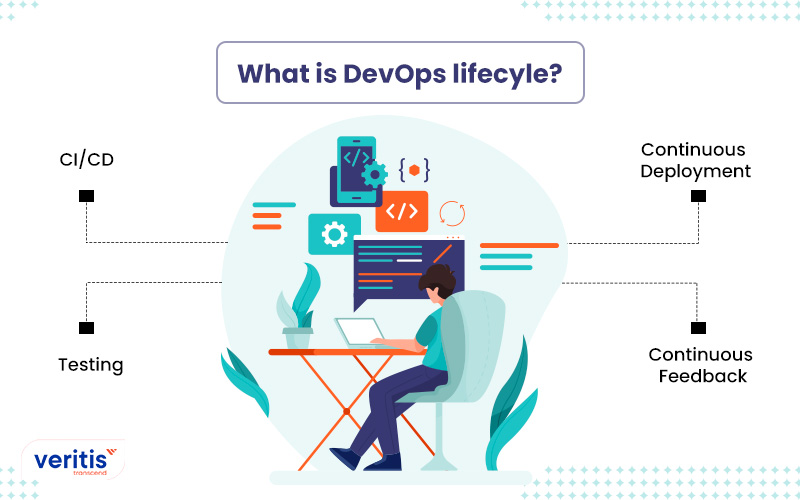
Continuous software development, integration, testing, deployment, and monitoring are all parts of the DevOps lifecycle. Therefore, a competent DevOps lifecycle is required for the DevOps techniques to be fully utilized. The DevOps methodology supports continuous innovation, agility, and scalability to create, test, use, and improve software products. It encourages a mindset of ongoing learning, experimenting, and feedback to reinvent goods, services, and procedures. A thorough understanding of the many stages of the DevOps lifecycle is essential for implementation, though.
Developers must understand the entire DevOps process to deliver results faster. Otherwise, the process may become difficult and time consuming. The DevOps lifecycle is broken down into its parts and thoroughly examined here.
The DevOps lifecycle involves the enterprise in continuous development and optimizes development processes from start to finish, leading to shorter delivery timeframes. The following seven stages make up the majority of this process.
1) CI / CD: Continuous integration (CI) includes various processes linked to the execution of the test process. Clients also contribute information that expands the application’s functionality. During this stage, the source code changes the most. Since developers frequently change CI/CD, they can rapidly identify and address issues before they become more serious. Small incremental features are continuously integrated with the source code throughout this phase. Because of continual development, the system’s upgraded code integrates seamlessly.
One of the most well liked tools for continuous integration is Jenkins. It helps retrieve the latest code and build executable binaries. The program is planned and coded in a continuous development cycle, allowing the DevOps team to accelerate the entire software development process. During this phase, the vision for the entire development cycle is defined, enabling developers to fully understand project requirements. As a result, the team begins to picture its ultimate objective.
While various version control systems are used to manage code, no DevOps automation tools are necessary for planning. JIRA, Git, Mercurial, and SVN are standard source code maintenance technologies. Other tools, like Ant, Gradle, and Maven, are available to package the codes into executable files. The following step in the DevOps lifecycle receives these executable files.
2) Testing: The testing phase, which comes next in the DevOps lifecycle, involves checking the developed code for faults and defects that may have crept in. Quality analysis (QA) is crucial in determining whether the generated software is usable. The program must pass the QA process to meet the client’s requirements. Continuous testing uses automation tools such as JUnit, Selenium, and TestNG to enable the QA team to simultaneously examine multiple code bases. This ensures that the generated program functions flawlessly.
3) Continuous Deployment: Continuous deployment (CD) does not harm the application’s performance, guaranteeing hassle free product deployment. During this stage, it is crucial to ensure the code is accurately deployed across all accessible servers. This method eliminates scheduled releases and speeds up the feedback system, enabling programmers to fix problems more efficiently and precisely.
4) Continuous Feedback: It’s imperative to have ongoing feedback to assess and evaluate the application’s final result. It establishes the framework for enhancing and rolling out a new version in response to stakeholder feedback. Analyzing the outcomes of the software operations is the only way to improve the development process of apps. Information obtained from the client’s side is all that feedback is. Information is vital because it contains details on the software’s performance and any problems associated with it. Additionally, it includes recommendations made by the software’s users.
Useful link: Why Should You Adopt DevOps and What are the Benefits it Offers?
What are DevOps Tools?
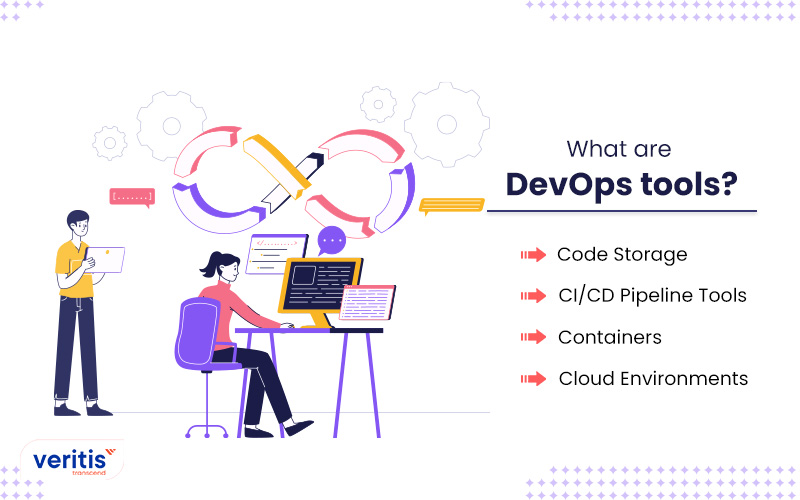
DevOps is a way of thinking, not a set of tools. However, an IT team struggles to accomplish much without the proper equipment. DevOps professionals frequently use containers, cloud hosting, and a CI/CD pipeline. Tools may be distributed using open source or proprietary software or fall under either category.
- Code Storage: Thanks to version controlled source code repositories, multiple developers can collaborate on code. In addition, these tools track source code modifications. Without tracking, developers can find it challenging to keep up with the latest changes and the code versions available to users. The following steps in a CI/CD pipeline, such as static code analysis, build, and unit tests, are automatically triggered when a code change is committed in the version control repository. Git and GitHub are two source code management tools.
- CI/CD Pipeline Tools: Through DevOps automation services across the development lifecycle, CI/CD enables DevOps teams to validate and frequently deploy apps to the end user. Developers can write, test, and validate code in a shared repository as often as needed without manual tasks thanks to the continuous integration tool, which starts operations. Continuous delivery expands these automatic steps through configuration configurations for release management and production level tests. In addition to tests, setup, and provisioning, continuous deployment includes monitoring and, if needed, rollback capabilities. Jenkins, GitLab, and CircleCI are standard CI, CD, or both tools.
- Containers: How can we forget containers? They are such an integral part of DevOps. On a shared OS, containers are segregated runtimes for software. Containers offer abstraction so that, from development to testing and staging to production, code can function the same way on many underlying infrastructures. Although Microsoft provides specialized Windows container solutions, Docker is the most well known containerization program. Container orchestrators automate the deployment, scaling, and maintenance of containers. Examples include Kubernetes services, Red Hat OpenShift, and Amazon Elastic Kubernetes Service.
- Cloud environments: Because they can automate cloud infrastructure deployment, scaling, and other administration activities, DevOps organizations frequently implement cloud infrastructure simultaneously. Among the most popular cloud services are AWS and Microsoft Azure. Many cloud suppliers also provide CI/CD services.
- Monitoring: Thanks to monitoring tools, DevOps experts can also monitor the efficiency and security of code releases on infrastructure, networks, and systems. They can mix operational intelligence producing analytical technologies with monitoring. DevOps teams use these automation tools to examine how code changes affect the environment. There are many options, including New Relic One, Dynatrace, Prometheus, Datadog, and Splunk.
- Collaboration: As understood, communication and collaboration are essential to DevOps production. DevOps tools facilitate this aspect, and Slack, Microsoft Teams, and other messaging applications are gaining popularity.
- Microservices: A single application can be built as a collection of small services using the microservices architectural design strategy. Each service has its running process and communicates with other services using a lightweight mechanism and a well defined interface. Microservices can be created using a variety of frameworks or programming languages and deployed individually, as a single service, or as a collection of services. Organizations may also adopt a microservices architecture to increase system flexibility and enable rapid innovation. Each service often has a small, agile team responsible for it.
Useful link: Top 10 DevOps Tools to Pick for Your Business
What are the Benefits of DevOps?

It is crucial to realize that DevOps is a technological approach, not a magic wand. There are some obstacles to overcome. Thus, one must gradually increase the use of DevOps services and solutions. Additionally, DevOps should never be used to solve workplace culture issues.
While DevOps brings a culture shift, it does not address your existing problems. Instead, it makes sense to encourage the development of competent team members who can leverage DevOps and instill a strong interest in the practice among the rest of the team.
Other advantages besides automation would persuade you. It’s easier than ever for your customers to leave if they’re unsatisfied, since SaaS is the most widely used model for software licensing. If your company’s strategy is based on recurring subscriptions, this could substantially influence your income stream.
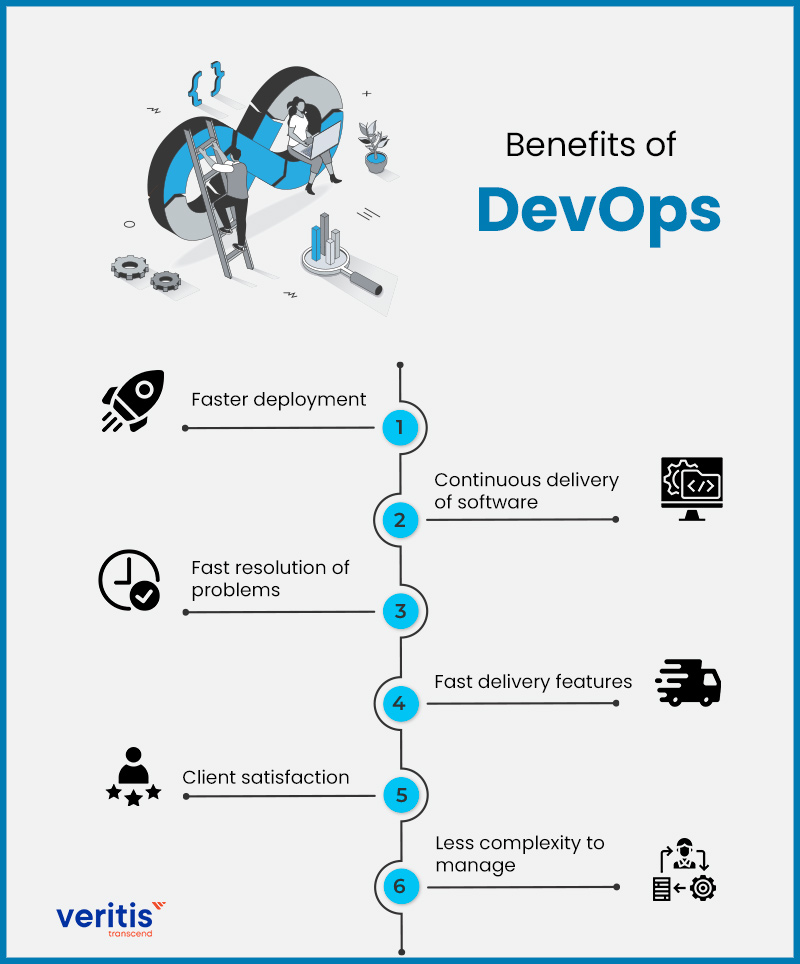
Containers simplify maintenance, and developers use them to improve the project lifecycle and the final product. As most businesses struggled to manage virtual machines for their local development and testing environments, containerization gained traction.
Explore DevOps Consultancy Services
What are the Major DevOps Challenges and Issues?
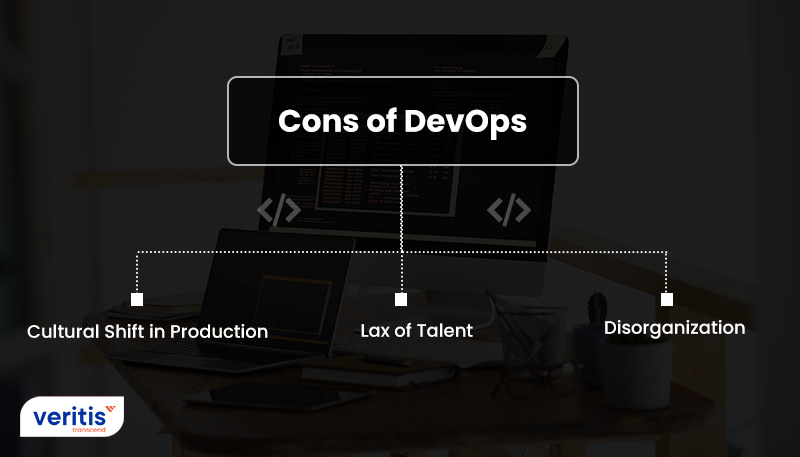
Drawbacks with DevOps are more challenging. Let’s explore those challenges.
1) Cultural Shift in Production
Before DevOps, developers and operational staff members worked in different groups. However, with DevOps, the developers pass off the iterative update, and operations staff must test it. This is just one aspect of DevOps services. The team must comply with many other changes, which may cause problems and friction.
2) Lack of Talent
The team may be left in a lurch as DevOps principles require training. And given the culture shift, trained hands are required at the helm. However, searching for talent is a task in itself, and most do away with this by having an MSP handle DevOps production.
3) Disorganization
The tandem working style will likely confuse who is working on what. Therefore, proper work demarcation is needed, as failing to overcome this challenge would waste time.
Useful link: 8 DevOps Adoption Challenges Businesses Must Overcome
What is the Difference Between DevOps and DevSecOps?

The DevOps collection of technologies, methods, and mindset combines and automates software development and IT teams’ processes. DevSecOps is an acronym for development, security, and operations. Security is automated at each phase of the SDLC.
DevOps’ primary objective is to eliminate communication gaps between teams, speeding up the development and deployment of new code. DevSecOps services aim to ensure security throughout development while enhancing accessibility, scalability, and speed. While DevOps focuses on software development and automation, DevSecOps emphasizes the crucial role of developers in writing secure, compliant code. Their job is to minimize downtime and data loss. These are the main differences between DevOps vs DevSecOps.
Get Started with DevOps
An organization must discuss several issues during the DevOps adoption process, from cooperation to CI/CD. DevOps is more than just a production method; it is not for everyone’s taste. Most people remove this by using an MSP like Veritis, the Stevie Awards winner in the DevOps consulting services.
Veritis has created cutting edge solutions for a range of clients. We have the DevOps knowledge to meet your demands, whether you’re a Fortune 500 firm or a startup. Contact us with your specific requirements, and we’ll create custom solutions that help you reach your full potential.
Got Questions? Schedule A Call
Additional Resources:
- DevOps Configuration Management: A Guide to the Top Tools in the Field
- Demystifying MLOps vs DevOps: Understanding the Key Differences
- Measuring DevOps: Key ‘Metrics’ and ‘KPIs’ That Drive Success!
- Top 10 DevOps Skills Every Aspiring DevOps Engineer Needs in 2025
- Building a High Performing DevOps Culture: Strategies and Best Practices for CEOs and CTOs
